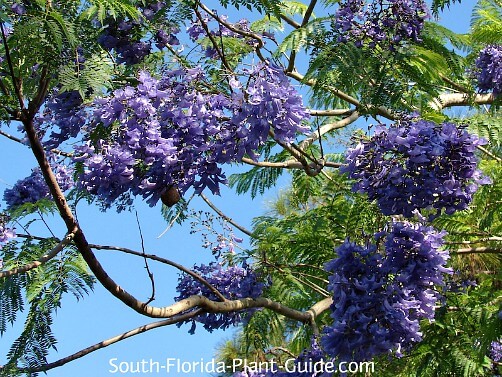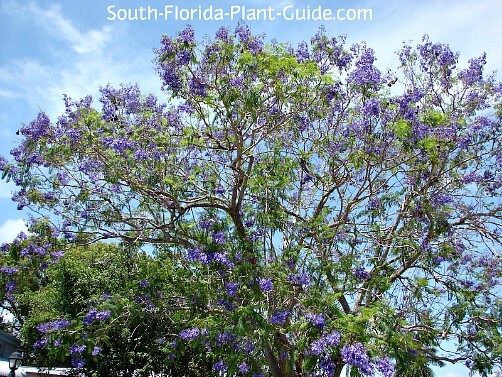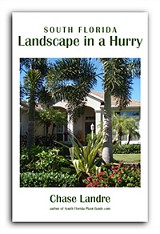Jacaranda Tree
Jacaranda mimosifolia
The downright gorgeous jacaranda tree heralds springtime in South Florida with feathery new foliage and immense purple flower clusters.

One of the most beautiful spring flowering trees, the jacaranda blossoms in April or May after the bare branches of this briefly deciduous tree begin sprouting new growth.
This is a big tree, best used as a single yard specimen in a medium-size yard, or anywhere that works well on a larger property.
The bright lavender flower clusters are huge - up to 12 inches long and as much as 8 inches wide.
Some people consider this beautiful tree "messy" because as the petals fall they blanket the ground beneath the tree.
Placement on a lawn rather than by sidewalks or drives makes the fallen blossoms more picturesque with little or no clean-up needed.
Jacarandas take a while to flower - if you plant from grafted cuttings (what nurseries sell) your tree will begin flowering when it's between 5 to 7 years old. Plants grown from seed (such as you'd get from a well-meaning friend) take much longer.
Once the jacaranda flowers are done for the season, the leaves fill in with fine-leafed foliage to create a dappled shade environment beneath the canopy.
Growing with a somewhat funky shape when young, the branches form a nice rounded crown when the tree reaches about 20 feet tall.
Have a large property? Consider planting one each of jacaranda, royal poinciana and peltophorum ("Yellow Poinciana").
These three lookalike trees (hard to tell apart unless they're flowering) will give you plenty of vivid, long-lasting landscape color:
Jacaranda - purple flowers in spring
Royal poinciana - red flowers in early to mid-summer
Peltophorum - yellow flowers in late summer to early fall
Plant specs
A jacaranda is a fast grower to 40 feet tall. It prefers a full to partial sun location with plenty of elbow room.
These trees do best in Zone 10.
They're usually deciduous for a brief spell in late winter except in warmest areas of South Florida (or they may keep some leaves throughout a warmer winter in normally colder areas).

Plant care
Add top soil or organic peat moss to the hole when you plant. You can also add in composted cow manure to enrich the soil around the tree's rootball.
Trimming isn't necessary, though you can trim the branch ends (after flowering is done) to promote denser growth.
Low-growing branches may need to be pruned to give more room for foot traffic or driveway access.
Leave a good-sized space around the base of the tree - either mulched or with a bed of other plants. The tree's bark is thin and can be easily damaged by weedwackers and lawnmowers.
Stake a jacaranda tree for the first year of its life - young trees can be blown over by a strong wind.
These are drought-tolerant trees once they're established, but water regularly at least for the first year. Then continue with an irrigation schedule that allows enough time between waterings for the plant to dry out.
Fertilize 3 times a year in spring, summer and autumn with a top-quality granular fertilizer.
Plant spacing
Like all fast growers, these trees can be dangerous during a hurricane or strong tropical storm. The branches can be weak and prone to breakage.
Place a jacaranda at least 15 feet (20 feet would be even better) from the house to accommodate the tree's wide spread and to prevent any house damage from falling branches.
Keep these trees at least 15 feet or more from walks or driveways so roots won't eventually cause problems.
You can grow a jacaranda tree in a container while it's young, but it should be placed in the ground as soon as possible to get it established. Young trees won't give you flowers anyway so container-growing is a waste.
Landscape uses for the jacaranda tree
- stand-alone specimen tree
- large anchor for a garden bed
- lining the property border (where growing over a neighbor's yard won't be a problem)
- shade tree
- along both sides of a large driveway to create an overhead arching effect
GOOD SNOWBIRD PLANT? NO
COMPANION PLANT SUGGESTIONS: For a bed beneath the jacaranda, plant low growers that will adapt well to more shade as the tree matures. Consider things like liriope, Indian hawthorne, foxtail fern, Japanese boxwood, asiatic jasmine (jasmine minima), and purple queen.
Other trees you might like: Queen Crape Myrtle, Tabebuia Trees
Take a break!
The ultimate guide to low-maintenance plants
and landscaping!
An ebook by
Chase Landre
author of
South-Florida-Plant-Guide.com
Learn more!
Get a greener thumb!
Want to learn more about South Florida planting, watering, fertilizing and dealing with weeds and pests?
See our Gardening How-To section for answers!
Get instant curb appeal!
An ebook by
Chase Landre
author of
South-Florida-Plant-Guide.com
Learn how to get instant curb appeal with fast growing plants and landscaping techniques!



